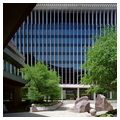Beginning at the southwest corner of 16th and M streets, the National Geographic Society now occupies four distinct buildings extending a whole city block to 17th and M streets. The earliest building in the complex, Hubbard Memorial Hall, was constructed in 1902 after designs by Hornblower and Marshall. The adjoining Administration Building, completed in 1932 after designs prepared by Arthur B. Heaton, makes a compatible Renaissance Revival style building; both are fashioned of buff brick with limestone trim.
At the corner of 17th and M streets, the ten-story building completed in 1964 represents a dramatic departure for the society. It is a sleek, modern structure designed by Edward Durell Stone. Narrow vertical fins of white Vermont marble separate vertical strips of glass pane, each framed in black Swedish granite spandrels and bronze. These luxurious materials form a curtain around a reinforced-concrete frame. On the interior, marble from the same quarry is used in the lobbies and entrance hall columns. The lobby leads to an “explorers' hall,” intended as a museum of science and discovery.
Tying together the older buildings along 16th Street with Stone's slab on 17th is the new office block of 1985 by Skidmore, Owings and Merrill facing M Street. The building resembles a pink concrete terraced mountain set back from the street and sidewalk. It offers a gardenlike respite in the midst of the downtown, as its large street-level plaza is furnished with plantings and large boulders, and its stepped-back stories are lined with shrubs.












